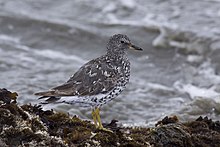Aphriza
| Surfbird | |
|---|---|
 |
|
| Scientific classification | |
| Kingdom: | Animalia |
| Phylum: | Chordata |
| Class: | Aves |
| Order: | Charadriiformes |
| Family: | Scolopacidae |
| Genus: |
Calidris Audubon, 1839 |
| Species: | C. virgata |
| Binomial name | |
|
Calidris virgata (Gmelin, 1789) |
|
| Synonyms | |
|
Aphriza virgata |
|
Aphriza virgata
The surfbird (Calidris virgata) is a small stocky wader in the family Scolopacidae. It was once considered to be allied to the turnstones, but more recent data suggests it is very close genetically to the red and great knots and should be included in Calidris. Indeed, the great knot looks very much like a larger, longer-billed, and somewhat darker surfbird.
This bird has a short dark bill, yellow legs and a black band at the end of the white rump. In breeding plumage, it has dark streaks on the brownish head and breast with dark spots on its white underparts; the upperparts are dark with rust colouring on the wings. Birds in winter plumage and immature birds are mainly grey on the upperparts and breast and white on the underparts with streaking. Their breeding habitat is rocky tundra areas in Alaska and the Yukon. The female lays 4 eggs in a depression on the ground lined with vegetation. Both parents look after the young birds, who feed themselves.
These birds migrate to the Pacific coasts of North and South America, from southern Alaska to Tierra del Fuego.
On the nesting grounds, these birds mainly eat insects and some seeds. At other times of year, they eat mollusks and crustaceans found along the surf line on rocky coasts and are usually found in small flocks, often with turnstones.
The song is a whistled tee tee tee.
...
Wikipedia

